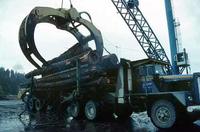Forest Industry
FOREST INDUSTRY is usually considered to include those economic activities related to the growing, harvesting and utilization of timber. They include the LOGGING, SAWMILLING, PULP AND PAPER, panelboard, SILVICULTURE and secondary manufacturing sectors. It is BC's largest industrial sector, directly and indirectly employing about 270,000 people in 2005. The industry was also the province's first. It began in 1788 with the production and export of masts by John MEARES, and in 1999 the BC industry accounted for about one-half of the entire Canadian forest industry, providing 8% of the world's exports of FOREST PRODUCTS. Most forest products produced in BC are exported, accounting for 46% of all provincial exports in 2001. The major customers, in order of importance, are the US, the rest of Canada, Japan and Europe. The forest industry experienced maximum production in 1987–88 when it cut a record 89.1 million cubic m of timber. During the last quarter of the 20th century it came under heavy criticism for its impact on the environment, and by the end of the century the timber harvest had been reduced to about 65 million cubic m (see also ENVIRONMENTAL MOVEMENT). Non-timber commercial use of the forests includes livestock grazing, trapping, collection of botanical products, outdoor recreation and TOURISM.

